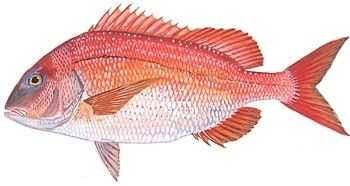Red Porgy

Species Details
Pagrus Pagrus
Sparidae
Perciformes
Rocky reefs, Jetties, Bays, Harbors
19 - 37 lbs.
13" - 36"
Red Porgy (Pagrus Pagrus) Description
Red Porgy, also known as the Common Seabream, has a pale red but metallic color hence its name. It has an oblong-shaped body and a rounded nose. Although its fins are composed mostly of rays, it also has spines distributed among them so they can be quite sharp. On appearance, the Red Porgy’s fins can look quite sharp. However, it’s only the dorsal fin that one needs to be careful of. The rest have a stiffer, feather-like texture.
The pectoral fins are yellow-orange in color and are quite long. If folded, the fins can almost touch the dorsal fin. The Red Porgy’s dorsal fin also stretches far back with its anal fin only being half the length of it. The Red Porgy also has a deeply forked tailfin that’s dull yellow but with red flecks on it. It has a medium-sized mouth and large eyes.
Diet and Size
A Red Porgy usually likes crustaceans, mollusks, and small fishes. Crustaceans such as small crabs and shrimps may strike its fancy. For mollusks, snails and clams can do the trick. They also like feasting on urchins and worms. Sometimes, a Red Porgy would even eat an occasional squid or two.
A Red Porgy is usually 13 inches long. Sometimes, they can grow up to 30 inches long if left undisturbed. However, there have been some reports that a Red Porgy can grow up to 35.8 inches long. They usually weigh around 4 lbs. However, adult ones have been known to weigh between 19 to 35 lbs.
Interesting Facts about the Red Porgy
- In some states, the Red Porgy may also be known as a Pink Snapper.
- However, this is a misunderstanding. The Pink Snapper’s scientific name is Pristipomoides filamentosus. Thus, it’s from a different family.
- A Red Porgy unlike its other cousins is the only one that has a round rear nostril. The others have slit-like nostrils.
- Red Porgies start off hermaphroditic. They eventually change gender which was found due to the male tissue in their bodies.
- Some say that the Red Porgy only changes gender because of certain environmental factors.
- Red Porgies are favored for their delicate white meat that flakes. Their skin also has a nice texture which is why many people favor this fish.
- Because of high commercial demand, Red Porgies have been studied and have been successfully subjected to aquaculture.
- Cooking methods for Red Porgies include steaming, baking, or sautéing.
Red Porgy – Fishing Techniques: How to Fish for a Red Porgy
When catching a Red Porgy, the best-known bait to catch them is either clams, worms, or squid. However, others say they’re not prone to be picky. They usually eat the bait as long as it’s small enough, unlike other fish. Usually, the bait for a Red Porgy should not exceed 2 inches.
Red Porgy is quite shy and won’t go near the boat just like that. Some anglers recommend using longlines, rods, and reels to bring it in. Others are okay with using handlines. However, some recommend also using fish traps where they end up trapping themselves while searching for crab. Another possible technique is via trolling though this works best when you’ve located a Red Porgy habitat.
Habitat and Distribution
A Red Porgy has a preference for warm waters. They stay near coastlines of more tropical climates. Although Red Porgies have a tendency to dive deep into the water (around 30 to 260 ft), most of the time they’re found near the surface. At times, catching a Red Porgy needs a little patience near the rocky areas. All you have to do is pop open a fish trap with some crab and wait for them to come.
Younger Red Porgies though prefer sea grasslands whereas older ones also like areas with soft sediments (i.e., sandy areas).







